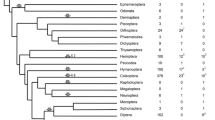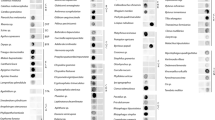Abstract
Single-stranded overhangs of the G-rich strand belong to the conserved features of telomeres composed of short telomeric repeats. These structures are thought to be essential for the maintenance of proper telomeric structure and function and the mechanism of their generation is telomerase-independent. We have examined the presence of single-stranded overhangs in Chironomus tentans, a dipteran insect lacking canonical telomeres that uses 350-bp repeats to terminate its chromosomes. Using a non-denaturing in-gel hybridization technique, we found that C. tentans telomeres are unlikely to have single-stranded overhangs longer than 30 nt found in most other higher eukaryotes. These differences might reflect special capping mechanisms for telomeres terminated with long complex repeats.
Similar content being viewed by others
References
Baumann P, Cech TR (2001) Pot1, the putative telomere end-binding protein in fission yeast and humans. Science 292: 1171–1175.
Biessmann H, Mason J (1988) Progressive loss of DNA sequences from terminalchromosome deficiencies in Drosophila melanogaster. EMBO J 4: 1081–1086.
Biessmann H, Carter S, Mason J (1990) Chromosome ends in Drosophila without telomeric DNA sequences. Proc Natl Acad Sci USA 87: 1758–1761.
Biessmann H, Mason JM (1997) Telomere maintenance without telomerase. Chromosoma 106: 63–69.
Birren B, Green ED, Klapholz S, Myers RM, Roskams J (1997) Analyzing genes, vol.1. In: Green ED, Birren B, Klapholz S, Myers RM, Hieter P, eds. Genome Analysis: A Laboratory Manual. Cold Spring Harbor: Laboratory Press, pp 91–148.
Carmona MJ, Morcillo G, Galler R et al. (1985) Cloning and molecular characterization of a telomeric sequence from a temperature-induced Balbiani ring. Chromosoma 92: 108–115.
Diede S, Gottschling D (1999) Telomerase-mediated telomere addition in vivo requires DNA primase and DNA polymerases alpha and delta. Cell 99: 723–733.
Dionne I, Wellinger R (1996) Cell cycle-regulated generation of single-stranded G-rich DNA in the absence of telomerase. Proc Natl Acad Sci USA 93: 13902–13907.
Dionne I, Wellinger R (1998) Processing of telomeric DNA ends requires the passage of a replication fork. Nucleic Acids Res 26: 5365–5371.
Garvik B, Carson M, Hartwell L (1995) Single-stranded DNA arising at telomeres in cdc13 mutants may constitute a specific signal for the RAD9 checkpoint. Mol Cell Biol 15: 6128–6138.
Gottschling D, Zakian V (1986) Telomere proteins: specific recognition and protection of the natural termini of Oxytricha macronuclear DNA. Cell 47: 195–205.
Griffith J, Comeau L, Rosenfield S et al. (1999) Mammalian telomeres end in a large duplex loop. Cell 97: 503–514.
Hemann M, Greider C (1999) G-strand overhangs on telomeres in telomerase-deficient mouse cells. Nucleic Acids Res 27: 3964–3969.
Henderson ER, Blackburn EH (1989) An overhanging 30 terminus is a conserved feature of telomeres. Mol Cell Biol 9: 345–348.
Horvath MP, Schweiker VL, Bevilacqua JM, Ruggles JA, Schultz SC (1998) Crystal structure of the Oxytricha nova telomere end binding protein complexed with single strand DNA. Cell 95: 963–974.
Huffman K, Levene S, Tesmer V, Shay J, Wright W (2000) Telomere shortening is proportional to the size of the G-rich telomeric 3'-overhang. J Biol Chem 275: 19719–19722.
Karlseder J, Broccoli D, Dai Y, Hardy S, de Lange T (1999) p53-and ATM-dependent apoptosis induced by telomeres lacking TRF2. Science 283: 1321–1325.
Klobutcher LA, Swanton MT, Donini P, Prescott DM (1981) All gene-sized DNA molecules in four species of hypotrichs have the same terminalsequence and an unusual 3' terminus. Proc Natl Acad Sci USA 78: 3015–3019.
Levis RW (1989) Viable deletions of a telomere from a Drosophila chromosome. Cell 58: 791–801.
Levis RW, Ganesan R, Houtchens K, Tolar LA, Sheen FM (1993) Transposons in place of telomeric repeats at a Drosophila telomere. Cell 75: 1083–1093.
Lin JJ, Zakian VA (1996) The Saccharomyces CDC13 protein is a single-strand TG1-3 telomeric DNA-binding protein in vitro that affects telomere behavior in vivo. Proc Natl Acad Sci USA 93: 13760–13765.
López CC, Nielsen L, Edström J-E (1996) Terminal long tandem repeats in chromosomes from Chironomus pallidivittatus. Mol Cell Biol 16: 3285–3290.
Makarov VL, Hirose Y, Langmore JP (1997) Long G tails at both ends of human chromosomes suggest a C strand degradation mechanism for telomere shortening. Cell 88: 657–666.
McEachern MJ, Krauskopf A, Blackburn EH (2000) Telomeres and their control. Annu Rev Genet 34: 331–358.
McElligott R, Wellinger R (1997) The terminal DNA structure of mammalian chromosomes. EMBO J 12: 3705–3714.
Munoz-Jordan J, Cross G, de Lange T, Griffith J (2001) T-loops at trypanosome telomeres. EMBO J 20: 579–588.
Murti K, Prescott D (1999) Telomeres of polytene chromosomes in a ciliated protozoan terminate in duplex DNA loops. Proc Natl Acad Sci USA 96: 14436–14439.
Nielsen L, Edström JE (1993) Complex telomere-associated repeat units in members of the genus Chironomus evolve from sequences similar to simple telomeric repeats. Mol Cell Biol 13: 1583–1589.
Nielsen L, Schmidt ER, Edström JE (1990) Subrepeats result from regionalDNA sequence conservation in tandem repeats in Chironomus telomeres. J Mol Biol 216: 577–584.
Nugent CI, Hughes TR, Lue NF, Lundblad V (1996) Cdc13p: A single-strand telomeric DNA-binding protein with a dual role in yeast telomere maintenance. Science 274: 249–252.
Pardue ML, Danilevskaya ON, Traverse KL, Lowenhaupt K (1997) Evolutionary links between telomeres and transposable elements. Genetica 100: 73–84.
Pennock E, Buckley K, Lundblad V (2001) Cdc13 delivers separate complexes to the telomere for end protection and replication. Cell 104: 387–396.
Pluta A, Kaine B, Spear B (1982) The terminal organization of macronuclear DNA in Oxytricha fallax. Nucleic Acids Res 10: 8145–8154.
Riha K, McKnight T, Fajkus J, Vyskot B, Shippen D (2000) Analysis of the G-overhang structures on plant telomeres: evidence for two distinct telomere architectures. Plant J 5: 633–641.
Rosén M, Edström J-E (2000) DNA structures common for chironomid telomeres terminating with complex repeats. Insect Mol Biol 9: 341–347.
Saiga H, Edström J-E (1985) Long tandem arrays of complex repeat units in Chironomus telomeres. EMBO J 4: 799–804.
van Steensel B, Smogorzewska A, de Lange T (1998) TRF2 protects human telomeres from end-to-end fusions. Cell 92: 401–413.
Walter M, Bozorgnia L, Maheshwari A, Biessmann H (2001) The rate of terminal nucleotide loss from a telomere of the mosquito Anopheles gambiae. Insect Mol Biol 10: 105–110.
Wellinger RJ, Wolf AJ, Zakian VA (1993) Saccharomyces telomeres acquire single-strand TG1–3 tails late in S phase. Cell 72:51–60.
Wellinger RJ, Ethier K, Labrecque P, Zakian VA (1996) Evidence for a new step in telomere maintenance. Cell 85: 423–433.
Williamson J, Raghuraman M, Cech T (1989) Monovalent cation-induced structure of telomeric DNA: the G-quartet model. Cell 59: 871–880.
Wright WE, Tesmer VM, Huffman KE, Levene SD, Shay JW (1997) Normalhuman chromosomes have long G-rich telomeric overhangs at one end. Genes Dev 11: 2801–2809.
Wyss C (1982) Chironomus tentans epithelial cell lines sensitive to ecdysteroids, juvenile hormone, insulin and heat shock. Exp Cell Res 139: 309–319.
Zhang YI, Kamnert I, López CC, Cohn M, Edström JE (1994) A family of complex tandem DNA repeats in the telomeres of Chironomus pallidivittatus. MolCellBiol 14: 8028–8036.
Author information
Authors and Affiliations
Rights and permissions
About this article
Cite this article
Rosén, M., Edström, JE. Chromosome Ends in Chironomus Tentans Do Not Have Long Single-Stranded Overhangs Characterizing Canonical Telomeres. Chromosome Res 10, 21–31 (2002). https://doi.org/10.1023/A:1014257808705
Issue Date:
DOI: https://doi.org/10.1023/A:1014257808705




